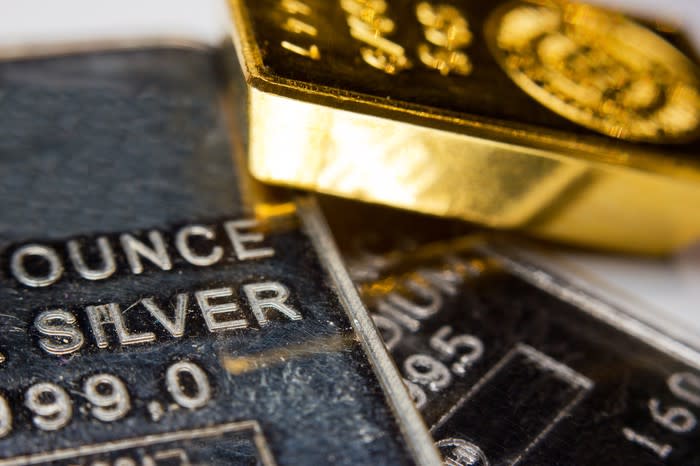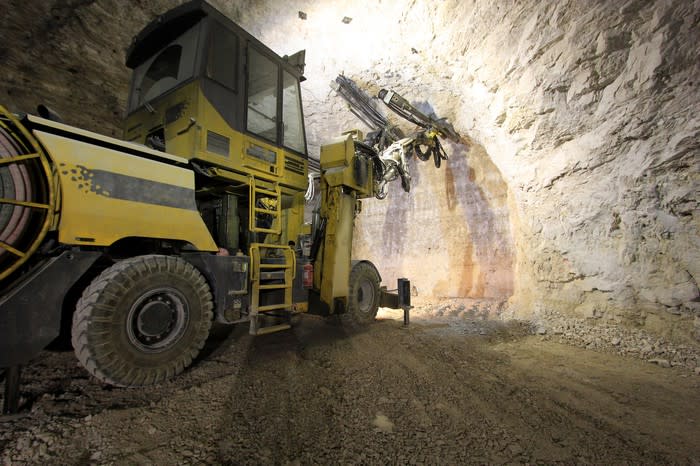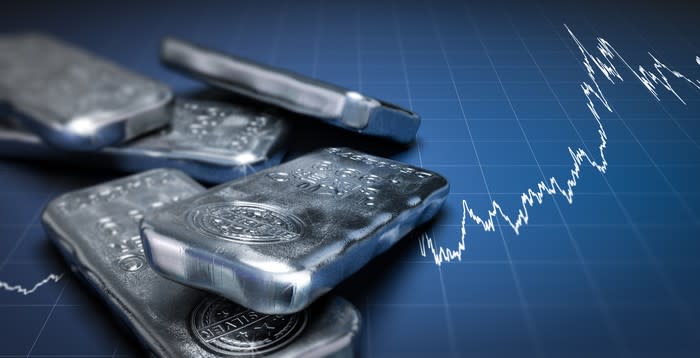17 Trillion Reasons to Own Gold and Silver Stocks Right Now
Historically, the stock market is the greatest creator of long-term wealth. Inclusive of dividend reinvestment, and when adjusted for inflation, it's returned an average of about 7% per year, working out to a historic doubling of wealth about once per decade. That means it's left all other asset classes eating its dust, including bank CDs, bonds, housing, and even popular safe-haven asset gold and its lustrous twin, silver.
You'll often hear analysts suggest that investors keep their distance from these safe-haven assets, given that they fail to pay a dividend and have drastically underperformed the broader market. But if investors consider a combination of the two -- i.e., avoid physical metals, but purchase gold and silver mining stocks -- they could be handsomely rewarded over the next couple of years.
Gold and silver are often referred to as "safe-haven" assets because they outperform during periods of uncertainty. If the stock market has a bad day, or a Trump tweet riles investors, investors might consider turning to gold as a store of wealth to ride out the temporary storm, so to speak.

Image source: Getty Images.
17 trillion reasons this rally isn't fool's gold
But there's more than mere emotions behind the rally that's sent gold and silver higher by 30% and 38%, respectively, over the trailing-one-year period. The fact is that there are 17 trillion viable reasons, and counting, why retail investors might seriously want to consider adding gold and silver miners to their portfolio.
According to Bloomberg, the aggregate value of global negative-yielding government bonds has now surpassed $17 trillion. That's up from "only" $8.3 trillion when the year began. Some of the bigger culprits of this negative-yielding debt include:
Japan: $7.3 trillion
France: $2.3 trillion
Germany: $2.1 trillion
Spain: $891 billion
Netherlands: $606 billion
Italy: $455 billion
Belgium: $415 billion
Austria: $300 billion
Sweden: $284 billion
This data suggests that investors are so worried about Europe's and Japan's economic prospects that they're willing to pay more than the face value of bonds just to "protect" their money. Then again, the idea of losing up to 0.5% annually isn't appealing to Yours Truly, no matter how you slice the data.

Image source: Getty Images.
More importantly, that's $17 trillion worth of existing notes that aren't providing residual income for investors. As noted, the biggest drawback of gold and silver is that, as physical metals, they don't provide any yield. When yields rise, gold and silver tend to perform poorly, because investors will opt for the safer return of bonds over yield-less metals. But when yields drop -- or in this case plunge off a cliff -- it makes physical metals look considerably more attractive to investors looking for a store of wealth.
And, in all reality, this $17 trillion figure is highly conservative, because it's not taking into account bonds that are losing investors money on a realized basis. In other words, if you were to go buy a 10-year U.S. Treasury bond right now, you'd receive about a 1.5% nominal return on your investment each year. But, according to the Bureau of Labor Statistics, the U.S. inflation rate in July 2019 was 1.8% over the trailing-12-month period. That means you'd be losing about 0.3% on a realized annual basis. I'd contend there are likely trillions of dollars in outstanding U.S. and global debt that has a marginally positive yield that doesn't surpass the domestic inflation rate, and is therefore leading to a realized negative yield. This, too, increases gold's and silver's luster.
You'd also be wise not to overlook the Fed's about-face on interest rates in July. After three years of calculated but steady rate hikes, the Fed reduced its federal funds rate for the first time in over a decade. This move from monetary tightening to loosening is the icing on the cake for the gold and silver rally.

Image source: Getty Images.
Avoid precious metals: Buy gold and silver stocks instead
Although the one-year gains in gold and silver might sound enticing, the long-term performance of physical metals pales in comparison to the publicly traded companies that mine and produce these metals. That's because unlike a physical ingot, companies have the ability to respond to changes in the marketplace, and they may even pay a dividend, allowing investors an opportunity to generate regular income.
What I believe makes gold and silver miners such an exciting opportunity right now -- aside from plunging global yields and monetary loosening from the U.S. central bank -- is their considerably improved financials and operating performance relative to where the industry was 6.5 years ago, when gold last closed over $1,550 an ounce.
Here's a brief look at what all-in sustaining costs (AISC) were like during the second quarter of 2013 for a handful of the industry's biggest names:
Newmont Goldcorp (NYSE: NEM): $1,548 an ounce, including an impairment
Kinross Gold (NYSE: KGC): $1,072 an ounce
Barrick Gold (NYSE: GOLD): $919 an ounce
And here's the AISC for those same companies six years later:
Newmont Goldcorp: $1,016 an ounce
Kinross Gold: $925 an ounce
Barrick Gold: $869 an ounce
The point is that not only should Newmont, Kinross, Barrick, and other gold players see an increase in revenue as the spot price per ounce of gold rises, but more prudent spending habits introduced over the past six years, along with substantive debt reduction efforts, should translate into more of those revenue dollars making it to these companies' bottom lines.

Image source: Getty Images.
My two favorite precious metal stocks
The two companies I'm most excited about happen to be my two largest portfolio holdings (yes, there's some obvious bias here): SSR Mining (NASDAQ: SSRM) and First Majestic Silver (NYSE: AG). Then again, these are stocks I've held through acquisitions for a period of seven years and four years, respectively, with minimal selling, so rest assured I'm not looking for a quick buck.
SSR Mining is forecast to grow annual production at its flagship Marigold mine in Nevada by roughly 30% to 265,000 ounces of gold by the early part of the coming decade, while the Seabee mine, acquired via the Claude Resources deal, continues to surpass production expectations with ever-lower cash costs. SSR Mining also recently began production at the Chinchillas project, adding a new source of silver production, and buying out the 25% stake that joint venture partner Golden Arrow had owned. As one of the few gold-mining stocks with a net-cash position, SSR Mining is well-positioned to take advantage of higher spot prices.
Meanwhile, First Majestic Silver is on track to generate more of its revenue from silver (about 60%) than any other mining company. The transformational acquisition of Primero Mining brought the San Dimas mine into the fold. San Dimas is rich with gold deposits and has been a generally low-cost mine since its assimilation. With a handful of new silver mines set to come online over the next four years, and efficiency improvements being made at existing mines, it would not be surprising to see First Majestic's silver equivalent ounce production grow by more than 50% between 2018 and 2022.
More From The Motley Fool
Sean Williams owns shares of First Majestic Silver and SSR Mining Inc. The Motley Fool has no position in any of the stocks mentioned. The Motley Fool has a disclosure policy.
This article was originally published on Fool.com
